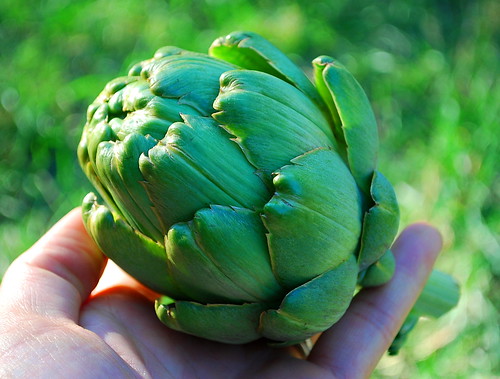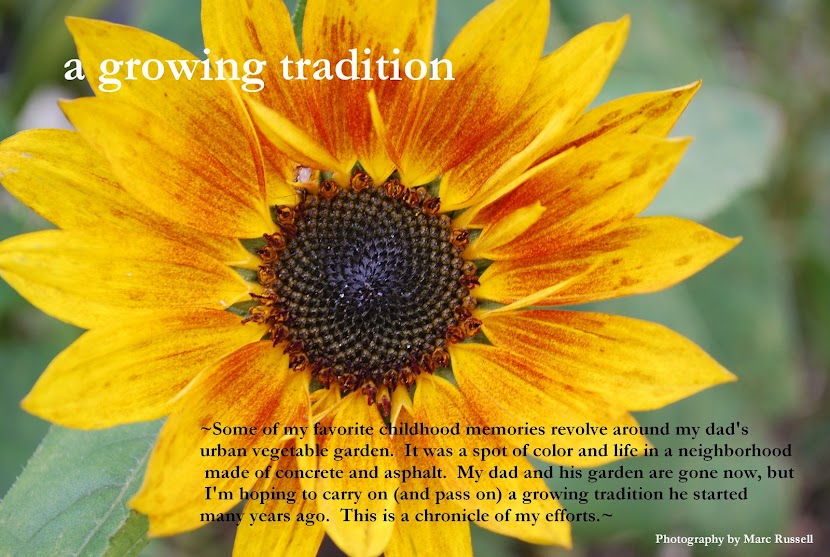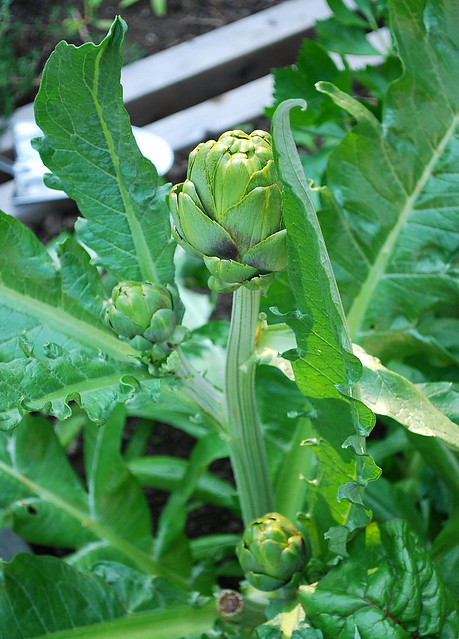Whenever someone visits my garden, they are usually most astonished to see artichokes growing. They often gasp, pause and then say something along the lines of "Wait, are those....artichokes?!" It always makes me smile for some reason. I seem to have an affinity for the exotic.
Admittedly, growing artichokes in our Zone 6 climate poses several challenges, the primary one being that the plant normally produces edible flower buds beginning in the second year. Unfortunately, artichoke plants generally are only hardy in Zone 7 or higher. The trick I've learned from reading Eliot Coleman's books is to start the seeds indoors in early February and provide the seedlings with 6 weeks of good lighting and warmth. Then they are moved to a location like a hoop house or cold frame where they are exposed to temperatures in the 40's and 50's F for at least another 6 weeks. This chilling period tricks the artichoke plant into believing that it has experienced winter, and hopefully coaxes it into sending up a flower stalk in mid-summer. As a result, gardeners in colder regions of the country can grow this plant as an annual and still reap a modest harvest.

I grew five 'Imperial Star' artichoke plants this year. As those of you who follow my blog may know, I tried starting a batch from seeds last winter only to have all but one of them succumb to aphids (originating from plants I'd purchased from an online nursery). The remaining four were purchased as healthy perfect-looking seedlings from a nearby nursery.
So how did my artichoke plants fair this summer? Ironically, the one I'd started from seed has provided me with 4 artichokes those far and will produce at least two more before our first frost. Out of the four seedlings I'd purchased, two have since sent up flower stalks and from these, I've harvested only two artichokes thus far. This leads me to believe that the seedlings I'd purchased were never exposed to the requisite chilling period or that they are of a different variety. I'm thinking it is the latter as the artichoke from these plants look and taste different from my 'Imperial Star'.
And how did they taste? The 'Imperial Star' variety is good but not great and I'd give the mystery plants (which I suspect are ordinary 'Green Globe' artichokes) a 9 out of 10. In any case, the challenge now will be to overwinter them in our cold climate. If I can do that, then next year should offer a bumper crop.







Oooh, that is exotic! Those are pretty chokes you got there. I don't cook artichokes enough to warrant us growing them. But they sure are pretty.
ReplyDeleteIf you don't cook them to eat, cook for the heart, which you can flash freeze on a cookie sheet before bagging to keep in freezer. They've never lasted long in my freezer,, so I don't know how long they stay good..
DeleteThanks you so very much for this lovely post on growing artichokes. I think that we have similar climate, only my winters are not as cold. My plan is to have a few artichokes as of next year, but from what I have been reading, they can overwinter here without any problems (I think this information was for Globe artichokes).
ReplyDeleteDid you consider growing some of those purple artichokes (Violeta de Provence or Violeta di Chioggia)? They look beautiful, but I am not sure about the taste.
Thanks about the info on starting the seeds indoors - that one is very helpful. Have you noticed that artichoke seedlings don't like their roots to be disturbed? (This is also what I have read).
I bought purple artichokes from a grocery store a few years ago, as a lark, and found that the entire stem is wonderfully edible and the taste is fantastic. Been on a hunt to find them in stores since, and now looking to try to grow my own, if possible.
DeleteHow will you overwinter them? In situ, but with lots of mulch for protection?
ReplyDeleteI keep wondering if I can actually keep things that are hardy to zone 7 alive here. I'm right on the cusp of the zones I think. The city really traps heat. My neighbor said there was a big rosemary plant growing here at one point and overwintering just fine. I'm going to have to experiment.
ReplyDeleteWay to go Thomas. I was thinking of giving them a try next year, I am in zone 7. We lived in Monterey, CA a few years, which is just literally down the road from the artichoke capital of the country, and I so miss eating those funny but wonderful tasting vegetable. I rarely buy them in the stores as they never look very good. You are right, the travel time does take a toll of the looks and flavor as well. Wish you the best for overwintering. Look forward to the spring to see how it went.
ReplyDeleteTheir peak is late winter -early spring. I won't buy them in store after mid - late spring, they're dry and almost woody.
DeleteI swore I wasn't going to try those again, but now you've made me want to give em another go! So how large did the overall plant get? One of the reasons I wanted to grow it was so I could incorporate it into the perennial beds as an edible, details please! Congrats on that artichoke!
ReplyDeleteOh Thomas they are just gorgeous! Maybe I will attempt it myself some day.
ReplyDeleteVrtlarica - I've been curious about the purple varieties but have never tasted them. I've heard that they are much more tender than the green ones. I've also read that artichokes do like their roots to be disturbed, which is why I stated Mine in soil blocks. However, the seedlings I purchased were pot-bound but transplanted just fine. They say that artichokes should not be potted up (in other words, they should be transplanted only once.)
ReplyDeletehenbogle - I'm gonna cut back the plants put a thick layer of dead leaves on top of the bed. Then I'll place down a layer of fabric row cover (to up the humidity) on top followed by hoops lined with 4 mil plastic.
Hi Erin - The plants are only about 2 feet tall. They really do look beautiful though. The foliage itself would add much to a perennial garden.
ReplyDeleteThank you for this informative post! I was looking at your older posts yesterday for garden expansion ideas, and totally got sucked into reading all your posts in chronological order. (I hope that doesn't make me sound like an obsessive stalker, even though I ignored all my other chores and read straight for like eight hours only with bathroom breaks - your blog was/is that good, and I was just in awe.) I read about your struggles with aphids on your artichoke seedlings from your mail ordered chrysanthemum, and how you were able to salvage just one seedling. I'm so glad to hear that it produced some beautiful artichokes for you.
ReplyDeleteBTW, I sent you an email yesterday with a couple of questions about your raised beds.
I feel inspired to try growing them. I am pretty sure I could grow them as a perennial in my area (zone 8b) but am hesitant to give up permanent growing space in the garden. Thanks for the tips on growing them.
ReplyDeleteWow, your artichoke growing is really impressive. I hope you get them to survive the winter. I'm so lucky to be living in the artichoke growing capital of the country and can enjoy them any time of year without the fuss of growing them. I had one plant for a while and just let it bloom. Someday you'll have to let one of the buds open so that you can enjoy their beautiful blossoms too.
ReplyDeleteThomas, you astonish me every time I read your blog. I want to be you when I grow up!
ReplyDeleteI managed once, long ago, to get a solitary artichoke in zone 4--mostly I was thrilled the plants got to a reasonable size in our short growing season.
Beautiful! That tomato harvest if amazing!! Also, if you can, try to let one or two artichokes bloom into flowers. They are breathtaking!
ReplyDeleteThomas ... I am keeping my fingers crossed for us both ... I took in about 8 chokes in all this year ... only 2 from plants started this year, so you are beating me there. I am going to use wall-o-waters and lots of mulch.
ReplyDeleteWell, here in NW Arkansas I'm giving these, my favorite veg. a try at growing them this year. I'm in about Zone 6a and I'm wondering HOW these little seedlings will get to be so BIG in the growing time! I've got an early jump on it as I planted them in mid March, and barring another freeze, hopefully they'll be able to get big and hopefully blooming! Thanks for the great post!
ReplyDeleteYou will understand from my question I am not an experienced gardner. Ok, if I begin the seeds in my home in February and give them 6 weeks of growing time and then move them into cooler temperatures for another 6 weeks. I'm assuming I then transplant them outside?? Ok, in doing all that, does it trick the plants in thinking it's the second year? If not, what do you do with the plants over the next winter? I read that they can be perennials, so how will they fair the Zone 6 winter?
ReplyDeleteadidas nmd
ReplyDeletetimberland outlet
vans outlet
moncler jacket
michael kors outlet online
yeezy
moncler
yeezy
yeezy 500
curry 6
yeezy boost 350
ReplyDeleteoff white shoes
yeezy
off white clothing
retro jordans
kyrie 5 spongebob
balenciaga
supreme clothing
yeezy shoes
supreme new york
replica nappy bags replica gucci bags j9t25z4c50 replica bags seoul replica chanel bags ebay click this g5z72g9w57 7a replica bags wholesale replica bags canada additional resources e6x12z7u34 replica bags pakistan
ReplyDeleteWest chester,pa zone 6ish
ReplyDeleteWe planted one artichoke plant 3 years ago. 2nd year it produced 4 large and 6 small chokes. It is on the south side of a non heated garage.We are almost sure the name was Empress Star, we are unable to find that variety again. Last year we added 3 Imperial Star plants. Total of 4 chokes. We have done nothing to protect any of the plants over winter.
It looks like the Imperials have passed away, the Empress is already 8” high in early april.
Putting in 3 more plants of whatever hardy variety we can find.
They all will definitely be mulched and hooped with plastic this year.
golden goose outlet
ReplyDeletegolden goose outlet
golden goose outlet
golden goose outlet
golden goose outlet
supreme outlet
golden goose outlet
golden goose outlet
supreme outlet
golden goose outlet